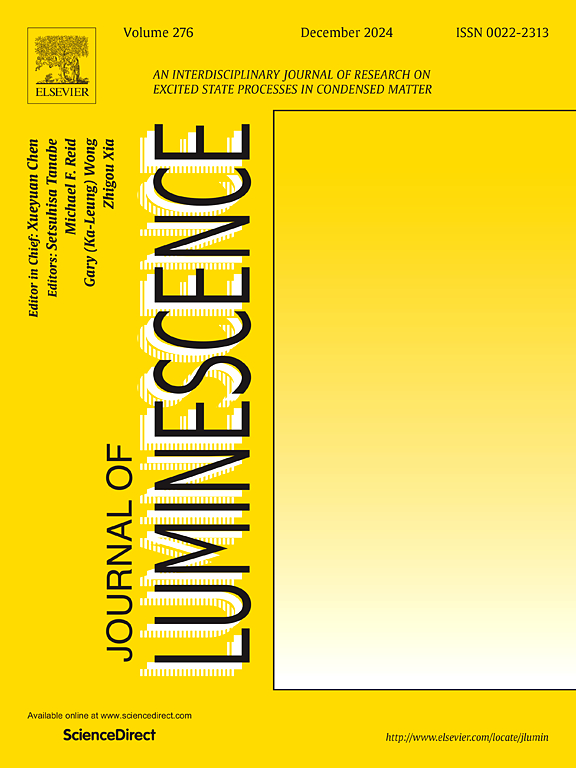Water-soluble carbon dots with AIE characteristics for latent fingerprints recognition and information encryption
IF 3.6
3区 物理与天体物理
Q2 OPTICS
引用次数: 0
Abstract
As a promising category of nanomaterials, carbon dots (CDs) have garnered extensive attention. However, reports of simple, cost-effective, and eco-friendly method for synthesizing CDs with good water solubility and aggregation-induced emission (AIE) characteristics are scarce. Herein, water-soluble AIE-active CDs are obtained from common green tea via a facile solvothermal method, which is not only facile to operate but also makes full use of the natural resources in green tea, and shows excellent environmental protection and sustainable development concepts. The presence of functional groups, including hydroxyl, carboxyl and amino, on the surface of CDs confirms their good water solubility by characterizing the CDs. The experimental findings on the effects of solvent, viscosity, and concentration validate the AIE phenomena observed in CDs. These phenomena are attributed to the restraint of surface group motions (such as carboxyl and amino groups) and the reduction of the non-radiative decay rate in their aggregated state. Ultimately, the CDs are demonstrated to possess significant potential for applications in latent fingerprints recognition and information encryption.

具有AIE特性的水溶性碳点用于潜在指纹识别和信息加密
碳点作为一种极具发展前景的纳米材料,受到了广泛的关注。然而,合成具有良好水溶性和聚集诱导发射(AIE)特性的CDs的简单、经济、环保的方法报道很少。本研究采用简便的溶剂热法从普通绿茶中提取水溶性aie活性CDs,不仅操作方便,而且充分利用了绿茶中的自然资源,具有良好的环保和可持续发展理念。在CDs表面存在羟基、羧基和氨基等官能团,通过表征CDs具有良好的水溶性。对溶剂、粘度和浓度影响的实验结果验证了cd中观察到的AIE现象。这些现象归因于表面基团运动(如羧基和氨基)的抑制和它们聚集状态下非辐射衰变率的降低。最后,证明了cd在潜在指纹识别和信息加密方面具有重要的应用潜力。
本文章由计算机程序翻译,如有差异,请以英文原文为准。
求助全文
约1分钟内获得全文
求助全文
来源期刊

Journal of Luminescence
物理-光学
CiteScore
6.70
自引率
13.90%
发文量
850
审稿时长
3.8 months
期刊介绍:
The purpose of the Journal of Luminescence is to provide a means of communication between scientists in different disciplines who share a common interest in the electronic excited states of molecular, ionic and covalent systems, whether crystalline, amorphous, or liquid.
We invite original papers and reviews on such subjects as: exciton and polariton dynamics, dynamics of localized excited states, energy and charge transport in ordered and disordered systems, radiative and non-radiative recombination, relaxation processes, vibronic interactions in electronic excited states, photochemistry in condensed systems, excited state resonance, double resonance, spin dynamics, selective excitation spectroscopy, hole burning, coherent processes in excited states, (e.g. coherent optical transients, photon echoes, transient gratings), multiphoton processes, optical bistability, photochromism, and new techniques for the study of excited states. This list is not intended to be exhaustive. Papers in the traditional areas of optical spectroscopy (absorption, MCD, luminescence, Raman scattering) are welcome. Papers on applications (phosphors, scintillators, electro- and cathodo-luminescence, radiography, bioimaging, solar energy, energy conversion, etc.) are also welcome if they present results of scientific, rather than only technological interest. However, papers containing purely theoretical results, not related to phenomena in the excited states, as well as papers using luminescence spectroscopy to perform routine analytical chemistry or biochemistry procedures, are outside the scope of the journal. Some exceptions will be possible at the discretion of the editors.
 求助内容:
求助内容: 应助结果提醒方式:
应助结果提醒方式:


